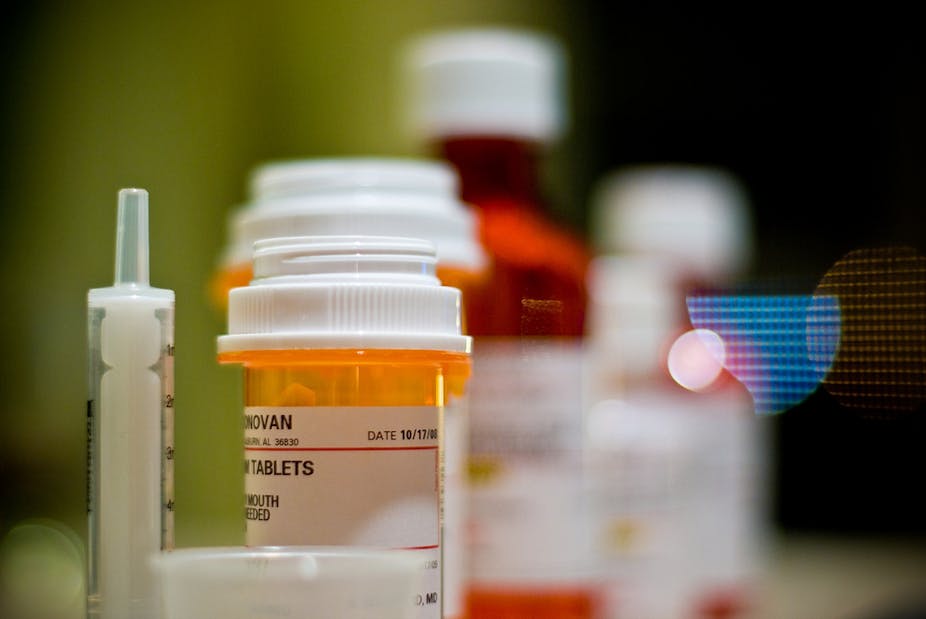A growing number of people globally live with chronic illness. By the time they reach 65, most Australians have at least one chronic condition and 80% have three or more.
Pharmaceutical treatment is often essential for managing these conditions and keeping people out of hospital, but costs can be substantial. Even with the assistance of the Pharmaceutical Benefits Scheme (PBS) the on-going expense of treating a chronic illness, or multiple illnesses, can cause financial hardship.
Consider an individual with three commonly co-occurring conditions: asthma, osteoarthritis, and acute coronary syndrome (a type of heart disease). Management of these conditions typically require eight different prescription medicines.
For a pensioner or other low-income earner with concessional benefits, the monthly cost of these PBS medicines is $45. A general beneficiary under the PBS would pay over $200 a month.
The problem with high monthly medicine costs isn’t just that it places stress on household budgets and potentially diverts spending from essentials, such as food and electricity. It’s that many patients stop taking their prescribed medicines.
A creeping problem
Recent surveys have shown that between 12% and 20% of Australians have skipped doses of medicine or not filled a prescription because of cost. Those most likely to report forgoing their medicines were the chronically ill, low-income earners, and people with high medicines costs.
Patients cutting back on medicines for financial reasons are more likely to experience a worsening of disease and require hospitalisation compared to those taking medicines as prescribed. This is socially and financially costly for individuals, families, and the community.
We know that increases in PBS medicine charges have adverse impacts on medicine use for some patients. In 2005, co-payments for PBS medicines increased by 21% for concessional and general beneficiaries. A comparison of PBS records before and after this 21% increase in co-payments showed significant falls in the number of prescriptions filled in 12 of the 17 medicine classes studied.
Prescription dispensings fell by between 3% and 11% and included many medicines essential for keeping people well and out of the hospital system (such as cholesterol lowers, anti-platelets, and medicines for asthma and osteoporosis). Concessional beneficiaries (who tend to be older, sicker and on lower incomes than the rest of the community) were most affected by the 21% co-payment increase.
We do not yet know how much the falls in medicine use have cost the community in terms of lost productivity and greater need for GP and hospital services.

But given what we know about the relationship between medicine costs and patients’ ability to access them, it’s important that PBS medicines are kept as affordable as possible. Affordable PBS medicines are especially important for the chronically ill, as they are the group most vulnerable to cost increases and most likely to experience health deterioration if medicines are not used.
Safety net solution
One of the key ways our health system supports the chronically ill is the PBS safety net. Separate to the Medicare safety net, the PBS safety net provides critical protection against on-going, high prescription medicines costs.
Once individuals or households have reached the safety net threshold – currently $348 for concessional beneficiaries and $1,363 for general beneficiaries – co-payments drop to $5.80 for general and to nothing for concessional beneficiaries. In this way, the PBS safety net greatly reduces or removes the cost burden of prescription medicines for the chronically ill for a period of time each year.
Unfortunately, many patients are missing out on the PBS safety net because they either don’t know about it, or are not able to keep the necessary documentation throughout the year to receive its benefits.
Unlike the Medicare safety net, which automatically comes into effect when patients have spent the threshold amount on medical services, patients have to keep track of their spending on PBS medicines using a safety net recording card. Patients need to present this card at the pharmacy each time they have a prescription filled and keep track of their spending until the safety net threshold is reached.
This requires a great deal of organisation and planning for individuals and families who may collect medicines at different times and multiple pharmacies.
Automation of PBS spending (this already happens for Medicare) would ensure that all eligible patients receive their entitlements. Without it, an unknown proportion of patients are currently missing out on their full PBS entitlements.
Automating the safety net will directly benefit individuals and families with chronic illness. But the benefits of appropriate medicines use extends to the entire community by allowing people to live healthier and more productive lives, and reduce pressure on hospitals and other health services.

